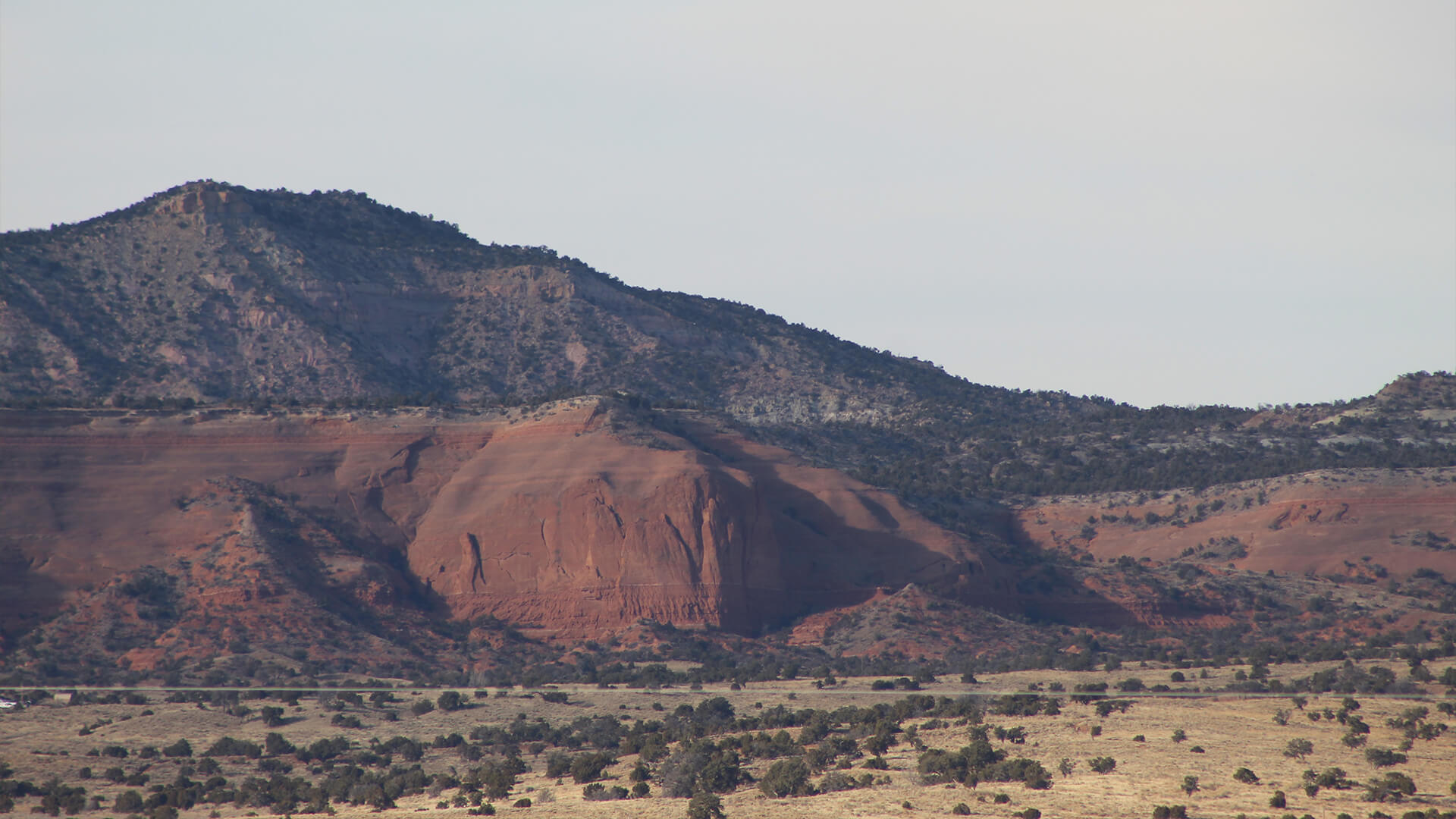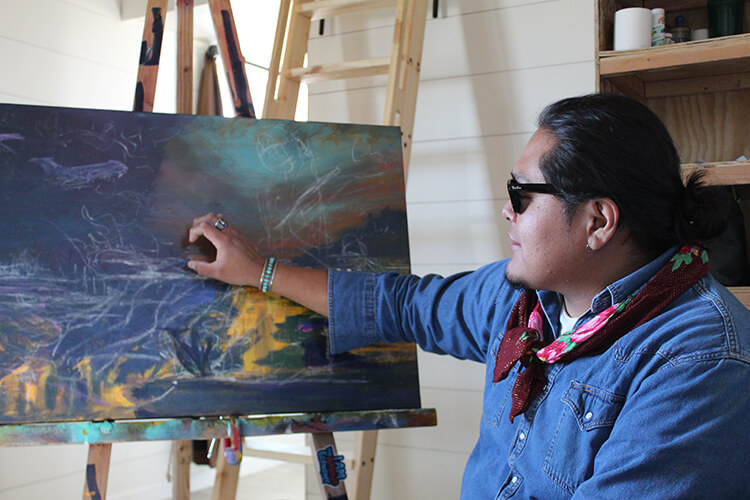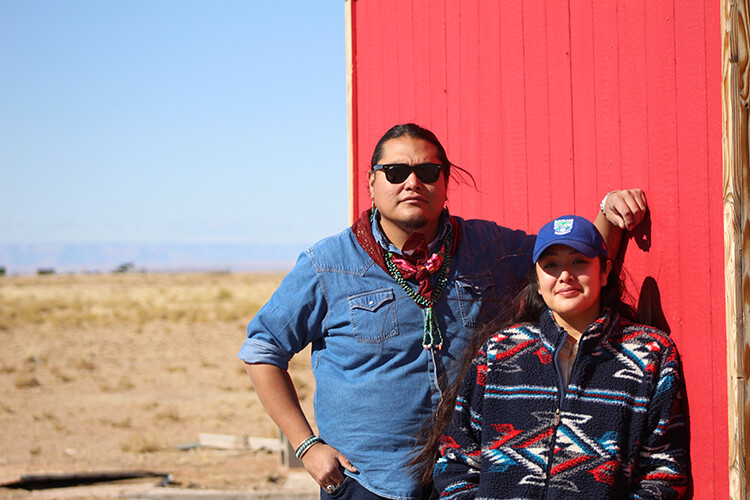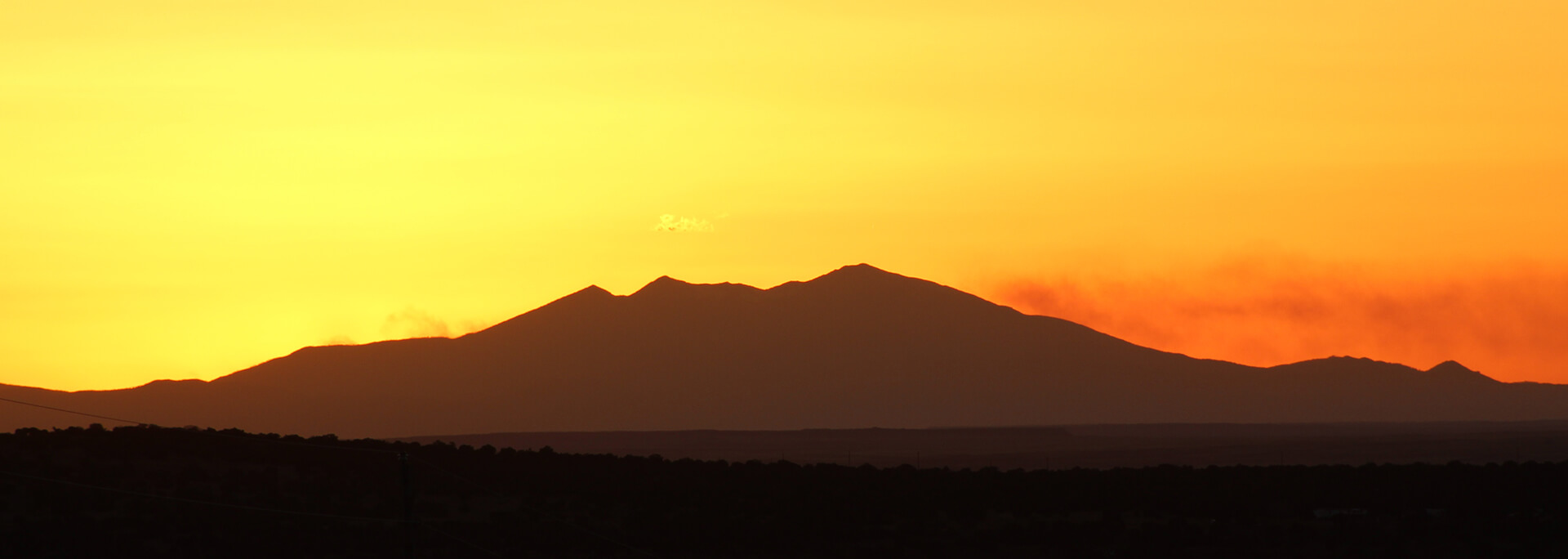“They just need someone to hear them... someone to see them... someone to feel them”
said Jacob Lee (MA 24, BS 14), describing the 38 students of the Nizhoni Accelerated Academy. Lee, one of only six staff members, is answering the call of his people and their land, helping some of the Navajo Nation's most troubled and nearly forgotten youth and young adults earn their high school degrees.
Lee embodies what he says, the feelings behind his message and the experiences he has felt aren't just relayed with words but emoted with the body.
Lee lowers his voice, his gaze dropping as he recalls one student who, before class each morning, would carefully empty his pockets of sticks and rocks. As the cold mornings passed, Lee simply listened to the young man, allowing trust to build in the quiet spaces he built into their conversations. Eventually, the student opened up and revealed that he was homeless, sleeping out in the open plains surrounding the school.
Lee's voice lifts again, and so too does his contagious smile as he proudly reports, "He is now just one class away from graduating."
For Lee, helping students earn their degrees is only part of the call. To truly serve his students, his people, and their land, he knows education must be reframed. In an interview on the Nizhoni Academy website, he reflected on how Western education often emphasizes a culture of "verticality"—a relentless climb upward, always reaching for something just out of grasp. Degree-earning, in this framework, becomes another rung on a ladder, a measure of progress defined by height rather than by depth. Lee reminds his students that learning is not just about ascent; it is about the growth of the soul and the self. For him, education is rooted in hozho—the beauty of the process itself. Unlike the rigid structure of a ladder, hozho moves in circular shapes, ever-reshaping, ever-evolving—an overlapping cycle of growth, healing, and transformation.
Greyhounds like Lee live their lives attuning to their call, sensing its pull, even as they are being shaped by it. To answer their call—to family, to community, to service, to self—is to move in rhythm with something greater, something uniquely their own. Their impact does not follow a straight path but radiates outward, like the widening circles of the wind, carving ripples into the desert floor with the ceaseless breath of the land.

Raised by his grandmother in Tł' ohchiní′—"the land of the wild onions"—in Ramah, New Mexico, Lee was steeped in the traditional values of the Navajo people. Educated in reservation school, he formed a deep connection to his language, culture, and traditions. His grandmother's encouragement carried him forward, but so did another image—Martin Luther King Jr.— a voice calling across time, in the background of his childhood, on his grandmother's television set. Inspired by both, he followed an early call of his own, one that led him to Eastern.
Lee loves the famous American novelist and essayist James Baldwin and quotes him often. "‘You go to church to find out what's wrong, and you go home to learn how to live with it,'" Lee remarks, quoting Balwin's biography "Go Tell It on the Mountain." For Baldwin, the church was a metaphor that represented the complex tension between positive and negative forces that ultimately lead one to a wider, less institutional, form of spiritual understanding. Jacob, too, experienced the complex tension of these forces throughout his adult life, faced with several challenges and moments of spiritual realization.
Once at Eastern, Lee found himself hundreds of miles removed from his home—both in distance and in spirit—Lee felt out of place, unwelcome in a world that seemed unwilling to make space for him. Jacob was ready to deny his call. Pride and a string of bad decisions left him untethered, homeless, and living out of his truck. Long before he was to meet the student outside Nizhoni Academy, emptying his pockets of sticks and rocks, Lee stood at the edge of a similar fate.
For the first time, his call fell silent. He was ready to walk away, to leave school, to turn his back on the path that had once felt so certain. But then, a moment of intervention—a conversation with Diana Cordova (MED 06) in Multicultural Affairs occurred. A single, unexpected encounter and the call returned.
"I sat in Diana's office, telling her I needed to leave school for a year to make some money. I had made poor decisions and been kicked out of the dorms, I was living out of my truck," Lee said. She listened, then spoke—not just of leaving, but of what leaving might mean.
She reached for a $20 bill, but before handing it over, she pulled him closer. "This is for food and gas, or you can hold on to this and double it. Work for me in the office of Multicultural Affairs and push through this challenge." At that moment, $20 felt like winning the lottery. But that evening, as he sat alone after class, a different emotion took hold. Hunger gnawed at him, but something deeper stirred. Staring at the bill in his hands, he wept. "You better be right," he thought, before tucking it away.
Ten years later, Lee still carries the same $20 bill in his pocket.
For Lee, answering the call is about transformation. "It means answering things we can't ignore. If someone needs help and you can lead, it's a transformative moment," he said. "How can we transform something from good to great, hurting to healing, sad to hopeful? It's about trusting that the journey has meaning."
 Inspired by Cordova's encouragement, Lee—though not an art student—felt a calling to express himself creatively. While still at ENMU, he found an abandoned house northwest of Portales, its walls cracked and fading, yet somehow still standing. Seeing possibility where others might see decay, he asked the property owner for permission to paint a mural—one that reflected his faith in Diana's words of challenge and transformation. On its crumbling surface, he painted the ghost image of a hummingbird and a single word: faith—a quiet, visual testament to the power of belief.
Inspired by Cordova's encouragement, Lee—though not an art student—felt a calling to express himself creatively. While still at ENMU, he found an abandoned house northwest of Portales, its walls cracked and fading, yet somehow still standing. Seeing possibility where others might see decay, he asked the property owner for permission to paint a mural—one that reflected his faith in Diana's words of challenge and transformation. On its crumbling surface, he painted the ghost image of a hummingbird and a single word: faith—a quiet, visual testament to the power of belief.
Lee speaks quickly, his words often unfolding in sharp, thoughtful aphorisms—not crafted by intention, but carried by knowing. One of his favorite things to say is, "Bloom where you're planted." And in ways both unexpected and unseen, his blooms return to him—taking root in places he never could have planned, unfolding in forms more beautiful and transformative than he could have imagined.
He later received a call from a woman who had spent her childhood in that very house. She shared a story, one marked by pain, loss, and wounds that had long refused to heal. Passing by the house one day, she had seen the mural—the hummingbird, the simple but powerful word: Faith—and in an instant, something shifted. A random act, yet not random at all. The image, the message, the moment—came instantly together and created a turning point for her, setting her on a path of healing.
Lee has come to understand that answering the call is rarely a solitary act. Paths cross, unseen forces weave lives together, and moments of impact ripple outward—connecting people who have never met, yet whose journeys are inextricably linked. Through art, he found a bridge between stories, a way to honor his own and to hold space for the stories of others.
After finishing college at ENMU, almost like a script unfolding along a predetermined path, Lee followed another call. A fresh graduate with a communications degree in hand, he was hired into a rhythm of resilience that seemed to align with his character, a competitive role in the Washington tech industry. With his natural charisma, sharp intelligence, infectious optimism, he quickly carved a space for himself in an environment where success was measured in promotions and growing salaries. For most early career IT professionals, this vertical route to a certain type of pinnacle of success, was ambitiously sought.
Gazing across the open, maroon plains of the Navajo Nation, Lee lifts his hand, drags it slowly through the air, tracing the distant mountains on the horizon, as if to punctuate a dreamlike memory.
"It was like I was living a dream. I would walk across the perfectly manicured green lawns of the corporate campus every day to my ideal office job. I was making more money than I ever thought I would, and I was working with great people doing great things."
Yet, beneath the surface of this idyllic existence, something felt unsettled. As he does when he becomes serious, when gravity pulls, his voice lowers.
"But something was off. It didn't feel right."
Though living what should have been his ideal life, he received devastating news—his grandmother had fallen ill. Each trip back to New Mexico became harder, and the distance between him and home became more unbearable as she pleaded with him to stay each time he returned.
Walking away from the nursing home after yet another emotional visit, he remembered looking back over his shoulder to the second-floor window and being transformed. As he glanced over his shoulder, there in the hazy shape of the raised window was the single hand of his grandmother pressed against the glass—and in that instant, he knew he had to answer a different call.
 Much like the woman who would later see his mural and find herself transformed, Lee, too, was set on a new course. The call he had tried to push aside roared back, undeniable. He knew, with absolute certainty, that he had to leave his life in Washington and return home—back to his people, back to his land, back to the source of his calling.
Much like the woman who would later see his mural and find herself transformed, Lee, too, was set on a new course. The call he had tried to push aside roared back, undeniable. He knew, with absolute certainty, that he had to leave his life in Washington and return home—back to his people, back to his land, back to the source of his calling.
Returning to the Navajo Nation, Lee embraced the artistic process more deeply than ever before. His return wasn't just a homecoming—it was a transformation. Like eclipses and radiating circles, animated by unseen forces, he found himself moving in a new direction, one that resonated with its own energy.
Not long after his return, the curator of the Runnels Gallery at ENMU invited him to exhibit his work—the work that had consumed him since leaving Washington.
In preparation for the show, he contacted Darienne Nez, an artist he deeply admired, one of three sisters raised in the heart of the Navajo Nation in Arizona. Part of the "triple threat," her father called her and her sisters—three college-educated Navajo women dedicated to their people and their land.
Lee's exhibition at ENMU brought him and Darienne together, and they have been building a life ever since—two callings intertwined, rooted in the land that Darienne's family has owned since their ancestors arrived after walking the Trail of Tears. Apart, they each carry an infectious optimism, eager to share the stories, traditions, and art of their families and their people. Together, they beam off of each other.
Darienne is quiet, more reserved, an active listener. But when she speaks, her words animate quickly, deliberately, as if each syllable has been carefully weighed. "We are so similar but so different," she said. "Jacob has been out living so many lives and meeting so many different kinds of people, experiencing so many other places and people. I have been here on this land working with my family and my sisters. But we are bonded by our love of this land and our faith in the future, no matter how dark or challenging things may look."
When asked how they remain optimistic, despite having so much to be bitter about, they answer almost in unison—a single word, echoing the "faith" Lee once painted in his mural.
"Compassion."
"That is how we have been taught," Darienne continues. "To give thanks for all that we have, to be compassionate to others, and to respect each other and our environment."
 We sit in a bright blue single-room home they have built within walking distance of Darienne's family home; on the land her family has tended since her childhood. A short walk beyond it, the octagonal foundation of a three-bedroom hogan has been dug in front of the loft where Lee crafts jewelry and paintings. Darienne, meanwhile, helps her family business, which has grown into one of the largest distributors of Indigenous clothing in the Navajo Nation. Together, they answer their call—to share their people's traditions and culture with the world, connecting us all through faith and compassion.
We sit in a bright blue single-room home they have built within walking distance of Darienne's family home; on the land her family has tended since her childhood. A short walk beyond it, the octagonal foundation of a three-bedroom hogan has been dug in front of the loft where Lee crafts jewelry and paintings. Darienne, meanwhile, helps her family business, which has grown into one of the largest distributors of Indigenous clothing in the Navajo Nation. Together, they answer their call—to share their people's traditions and culture with the world, connecting us all through faith and compassion.
At the end of our time together, they lead us on a rare and sacred walk into a canyon that Darienne calls Candy Cane Canyon, and Jacob calls, Colemine Canyon. It is a place seldom visited by non-indigenous people. The canyon walls swirl with minerals, red and white streaks twisting like ribbons through the rock.
Standing at the edge of the horseshoe-shaped expanse, which has long served as a natural hunting ground for the Navajo, Darienne tells the story of her grandmother.
She lived alone at the bottom of the canyon for much of her later life.
During the Navajo-Hopi land dispute, which resulted in the Bennet Freeze, redrawn land agreements displaced many Navajo people. Darienne's grandmother's land wound up on the wrong side of the map, but she refused to leave.
She rooted herself there, a single shotgun in hand, sustained by the land itself—grinding flour from a small salty shrub called Four-Winged Salt Bush. She would not be moved.
Eventually, the Hopi agreed to let her stay. She remained in the canyon until her family moved her to a nursing home where she still lives today. Her call echoes through the optimism and compassion of Darienne and Jacob as they build their life together on the ridge of that very canyon.

When you kneel down beside a Four-Winged Salt Bush and look through it, its rugged branches stretching toward the open sky, they look like the outstretched hands of ancestors parting the wind with their fingers. At another angle, the branches look like similar hands from the past, as if pressed against glass—like the single palm Lee once saw in a window, telling him not to leave, so he could answer his call.
And while resilient and always reaching to the sky through the most extreme climates, Four-Winged Salt Bush can become brittle and break—turn into tiny sharp sticks and catch in our pockets, mix with stones from the earth on which we sleep. Sometimes, a small stick and a rock in the pocket is all that holds us together in moments of displacement, when all we have for shelter is our memories, those from the past and our land.
This is where the circular patterns of our lives continually pass—divert away, and return through—a lifetime of orbiting a single place—where we learn to bloom where we're planted.
Where our call originates.


